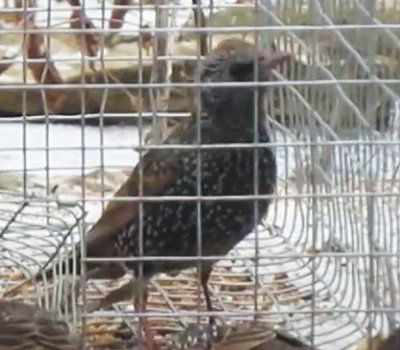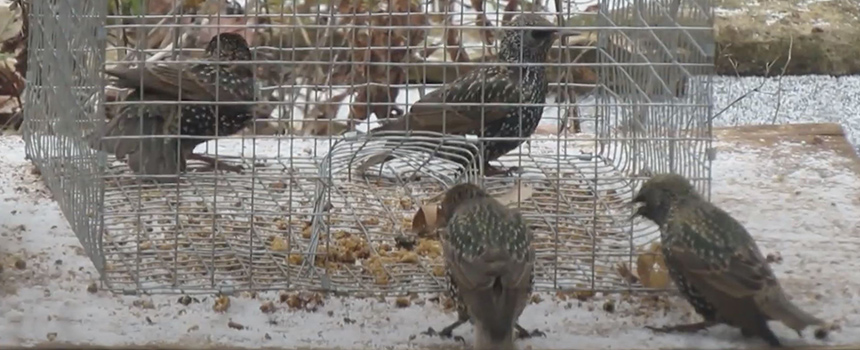- info@wildlifeanimalcontrol.com
Call us for help in your town
Wildlife Control Education
How to Get Rid of Starlings
 Problems Starlings Can Cause:
The list of problems associated with starlings can range from spreading diseases, obliterating crops, and damage to structures. In terms of diseases, starlings are carriers of things such as salmonella, blastomycosis, as well as other diseases that are easily transmissible to animals and humans. This poses a high risk to farmers because the animals on the farm can become infected by diseases from starlings which will then be transmitted to humans that eat them.
Starlings can also cause structural damage that will lead to costly repairs. A prime example of this damage is if a starling finds its way into a shed or building, they can make a nest in the rafters. Because these birds travel in flocks, typically, if there is one starling there are numerous others that will shortly follow. This can lead to sanitation issues from droppings that will cover any surface below nesting sites. In addition to being unsanitary, these droppings are also corrosive and will damage vehicles and property if not quickly removed.
Starlings also are extremely problematic for farmers who grow produce. Despite the fact that these birds prefer insects in their diets they will happily forage for berries and produce if available. In what seems like an instant they can completely decimate a crop. This is especially destructive for vineyards as even a short-lived starling infestation can completely destroy the income of the vineyard owner. When you couple the devastating effects of starlings on crops with the diseases that they spread, the problems that they pose to society are extremely serious.
Problems Starlings Can Cause:
The list of problems associated with starlings can range from spreading diseases, obliterating crops, and damage to structures. In terms of diseases, starlings are carriers of things such as salmonella, blastomycosis, as well as other diseases that are easily transmissible to animals and humans. This poses a high risk to farmers because the animals on the farm can become infected by diseases from starlings which will then be transmitted to humans that eat them.
Starlings can also cause structural damage that will lead to costly repairs. A prime example of this damage is if a starling finds its way into a shed or building, they can make a nest in the rafters. Because these birds travel in flocks, typically, if there is one starling there are numerous others that will shortly follow. This can lead to sanitation issues from droppings that will cover any surface below nesting sites. In addition to being unsanitary, these droppings are also corrosive and will damage vehicles and property if not quickly removed.
Starlings also are extremely problematic for farmers who grow produce. Despite the fact that these birds prefer insects in their diets they will happily forage for berries and produce if available. In what seems like an instant they can completely decimate a crop. This is especially destructive for vineyards as even a short-lived starling infestation can completely destroy the income of the vineyard owner. When you couple the devastating effects of starlings on crops with the diseases that they spread, the problems that they pose to society are extremely serious.
4 Different Ways to Get Rid of Starlings
Since the late 1800s starlings have been destroying property and spreading diseases all across North America. The small number that was originally released has since grown exponentially and with it the dangers and destruction that causes hundreds of millions of dollars' worth of damage every year. Their ability to survive in almost any environment as well as a willingness to eat almost any food source adds to the destruction and dangers that can be caused by this invasive species.
Nuisance starlings can cause a whole host of issues for anybody that come in contact with them. Their droppings are corrosive and will destroy your property as well as carry diseases that can be easily transmitted through contact. Because of these problems, it is imperative to remove starlings from your property before they cause any major issues. But before employing any removal strategy the perfect first step is to look at preventing starlings from creating nests in the first place which will avoid costly damage.

Nuisance Starling Prevention:
One of the best ways to stop starling damage is to prevent them from nesting and spreading disease in the first place. Using the proper tools and techniques at the start will save costly reparations you could have to make to remedy a starling issue. In terms of preventing starlings from creating nests on your property there are many options but most of them target areas that starlings prefer. These areas include rafters, holes, and any tall spot that can support a nest. Here are a few ways you can protect your property from starlings.
Fill Holes and Seal Openings:
One of the best ways to protect your property from starlings is to look for any holes and structures that could allow the crafty birds a path inside. Holes in the outside frame of roofing may look small but are ideal for starlings to enter and start building their nest. Once inside you have to worry about not only removing the starling but eradicating any damage they have caused for the time that they live there. This is far more costly than just sealing up the holes and checking to make sure they are plugged on a regular basis.
Meshes and Nettings:
Another great way to stop starlings from making a nest on your property or in your structures is to make other areas they prefer inaccessible. There are a few options you can use for this but a great one is a mesh or a netting that will prevent or restrict access. Utilizing this type of netting eliminates access the birds have to places such as the underside of roofs where the rafters and a-frames would otherwise make a great home for starlings. Utilizing this simple solution is a quick and effective way to stop the harmful birds from spreading diseases.
Nuisance Starling Traps and Repellents
If starlings have already invaded your property and set up shop it may be too late to use preventive measures. In order to get rid of these nuisance birds, you're going to need to employ various different tactics and then apply the aforementioned prevention methods. The key to this is that these should only be used as a last resort method and in order to be completely effective need to be followed with a prevention technique.
Repellents:
Before resorting to traps one way to handle a starling infestation that may prove effective is to utilize repellents to get the birds to leave naturally. One option you can use as a starling repellent is to get an audio device that emits a sound that humans cannot hear but it's highly undesirable to starlings. This is generally a non-invasive way to remove starlings so that you can apply prevention methods to ensure they don't return. For a more aggressive infestation you can also use a liquid repellent, but if you have other animals on your property you'll want to make sure that it doesn't cause any issues with them.
Traps:
The absolute last resort option for removing starlings from your property should be trapping them. When you select a starling trap you want to make sure that it will not harm the starling and the bird can be removed and relocated so that you can apply prevention measures, such as bird netting, that will ensure it will not return later. It should be noted that these traps should probably be installed by a professional as handling a distressed wild bird that carries diseases has significant risks.
Take Care of Your Starling Problem Today:
if you are in an area prone to damage and destruction caused by starlings it is imperative to make sure you scout and prepare all areas they could potentially make a home. It is always better to be proactive whenever it comes to nuisance animals of any form, and starlings are no exception. No matter what, if there is a present starling infestation or if you want to stop a future one, preventive measures are always the best solution for handling a starling problem.
Biology of Starlings
The starling is a distinguishable bird that can be identified relatively easily. Their name is derived for the shape of their body and wings which resembles a star. In terms of appearance they are a medium-sized bird and when viewed at length will appear to be completely black. Upon closer inspection, one will notice a purple in green shimmer similar to what can be viewed when sunlight hits oil. This is only how they look in the summer and in the winter they will attain a brown color with white speckles. Starlings are common in urban areas but can also be found in rural places that have been developed by humans. In terms of diet, starlings prefer insects but will also eat berries and seeds. Typically these birds will forage on the ground and they look for items such as worms, spiders, snails, and beetles. Whenever these items cannot be found however, these Birds will resort to eating fruits and berries, as well as anything else available. These birds are found all across North America whether it's summer or winter. The resiliency of these birds is part of the reason why they are generally considered pests and nuisances. The nesting habits of the species is one of the main complaints and also a reason they're so hard to get rid of. The starling will nest any place where there is a cavity such as a roof, stoplights, or tall buildings. When they do build their nests in these areas they can cause issues with the

















